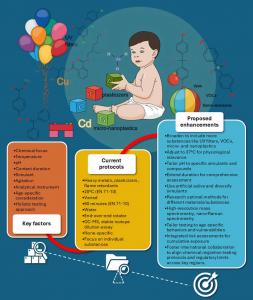GA, UNITED STATES, February 27, 2025 /EINPresswire.com/ -- Ensuring the safety of children's toys is a critical global concern, particularly regarding the migration of harmful chemicals. This study examines the evolution of chemical migration testing protocols, identifying key factors such as temperature, pH, and contact duration that influence the accuracy of these tests. The research proposes enhancements to current methods, advocating for more realistic testing conditions and a holistic approach to assess the cumulative risks of chemical exposure. By improving testing protocols and fostering global collaboration, the study aims to create safer toys for children worldwide.
Chemical migration testing is essential for evaluating the transfer of hazardous substances from toys to children. Historically, testing focused on metals like lead and cadmium, but as scientific knowledge advanced, the scope expanded to include plasticizers, flame retardants, and other chemicals. Despite progress, current testing protocols often fail to simulate real-world conditions accurately, potentially underestimating risks. Based on these challenges, there is a pressing need to refine and enhance chemical migration testing methods to better protect children from harmful exposures.
Researchers from the University of Southern Denmark have proposed significant improvements to chemical migration testing protocols for children's toys in a study (DOI: 10.1007/s11783-025-1961-3) published on January 2, 2025, in Frontiers of Environmental Science & Engineering. The study highlights the limitations of current standards, such as the European EN 71-10, and suggests adjustments to temperature, pH, and simulant choices to better reflect real-world exposure scenarios. The research also emphasizes the importance of considering age-specific vulnerabilities and cumulative exposure risks.
The study identifies several key factors that influence the effectiveness of chemical migration testing, including temperature, pH, contact duration, and the choice of simulants. Current protocols often use water at 20°C, which may underestimate migration rates. The researchers recommend adjusting the temperature to 37°C to better mimic physiological conditions. Additionally, they advocate for the use of artificial saliva and other simulants that more accurately replicate biological fluids. The study also highlights the need for extended contact durations to capture long-term risks and the importance of optimizing agitation methods to prevent local saturation. Advanced analytical technologies, such as high-resolution mass spectrometry, are proposed to detect chemicals at lower concentrations. The research calls for a more holistic approach, considering the interactions among multiple substances and age-specific behaviors, to provide a comprehensive assessment of health risks.
Dr. Elvis Genbo Xu, the corresponding author of the study, stated, "We underscore the need for more realistic and comprehensive chemical migration testing protocols. By aligning global standards and leveraging technological advancements, we can ensure that toys are not only fun but also safe for children worldwide."
The proposed enhancements to chemical migration testing protocols have significant implications for toy safety regulations globally. By adopting more accurate and realistic testing methods, manufacturers can better assess and mitigate the risks of chemical exposure in toys. This research also highlights the importance of international collaboration to harmonize safety standards, ensuring consistent protection for children regardless of where toys are produced or sold. Ultimately, these improvements will contribute to a safer environment for children, allowing them to enjoy their toys without compromising their health.
DOI
10.1007/s11783-025-1961-3
Original Source URL
https://doi.org/10.1007/s11783-025-1961-3
Funding information
This study was funded by the Nordic Exposure Group (NEXPO) under the Nordic Council of Ministers.
Lucy Wang
BioDesign Research
email us here
Legal Disclaimer:
EIN Presswire provides this news content "as is" without warranty of any kind. We do not accept any responsibility or liability for the accuracy, content, images, videos, licenses, completeness, legality, or reliability of the information contained in this article. If you have any complaints or copyright issues related to this article, kindly contact the author above.


